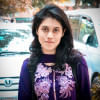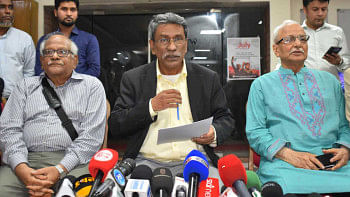Female-headed households rise to a decade high

Hasina Begum, a domestic worker in the capital's Tejgaon, has to provide for her five-year-old son, who is physically challenged. Her husband left them because of the child's condition, forcing the 32-year-old to become the sole breadwinner of the family.
She manages to earn Tk 11,000 a month by working in three separate houses about 10 hours a day on average.
The income might help her foot the bills for basic essentials and ensure the son's minimum well-being, specialised physiotherapy for the child is beyond her means.
"I am working hard to make a living," she said.
Shanta Akhter, a garment worker, lives in a cramped basement room in Mirpur-7. Her tiny, windowless 72-sqft room accommodates only a small bed.
The 29-year-old earns Tk 12,500 a month, supporting her entire family, which lives in Bogura. Her husband, a drug addict, has abandoned her.
"I have to send a major portion of my salary to my daughter and parents," Shanta said.
The 12-year-old daughter is studying in Class VIII and needs Tk 1,500 a month to meet educational expenses.
"I live alone in Dhaka and work in a garment factory so that I can give her a better life," Shanta said.
Nahar Jahan, who hails from Kamrangirchar, works in four households near the University of Dhaka, earning around Tk 20,000 a month.
Her husband, a rickshaw-puller, is drug addict and often demands money from her and resorts to violence if denied. Despite this, Nahar, aged 30, single-handedly manages a five-member family, which includes three of their children, with two in school.
Hasina, Shanta and Nahar are just three of the millions of women in Bangladesh who have been compelled to become the breadwinners of their families to survive.
The latest data from the Bangladesh Bureau of Statistics (BBS) shows a notable increase in female-headed households, reaching its highest level in a decade.
In 2022, some 17.4 percent of households were led by women, up from 16 percent the year before and 15 percent in 2020. It was 11.6 percent in 2013.
In South Asia, India has 17.5 percent of households with a female head, according to the latest data available with the World Bank. It is 31.3 percent for Nepal, 12.5 percent for Pakistan, and 44.3 percent for the Maldives.
Experts, however, are not pleased about the development, saying the growing number of female-headed households can lead to acute economic instability and increase the rate of poverty.
The notable increase in female-led households is particularly pronounced among women aged 15 to 60, who display a heightened propensity to shoulder familial responsibilities.
Even among older women, aged more than 60, there has been a noteworthy uptick in the proportion of female-headed households, rising from 19.1 percent in 2021 to 19.7 percent in 2022.
Syed Md Saikh Imtiaz, a professor of the Department of Women and Gender Studies at the University of Dhaka, describes women's increasing participation in the economic activity as a welcome development.
"Their income-generating activities are increasing day by day along with the proportion of women receiving education."
Prof Imtiaz, however, said more needs to be done to empower the female population by improving their educational, financial and mental condition.
He said men's attitude is not catching up with the way women are moving forward.
"Men can't accept this progress, leaving women in a situation to get separated. Women are not sitting quietly. Rather, they are standing on their own. Thus, divorce is increasing. We need to work more focusing on men as well."
From 2006 to 2021, the gross separation rate rose from 0.6 percent to 1 percent. In 2022, it reached 1.4 percent, according to the BBS.
Regional disparities in household headship are evident: Chattogram saw a surge of 2.2 percent in female-headed households in 2022, while Sylhet witnessed an uptick of 2.1 percent, according to the BBS.
Tahmina Akhter, a professor of the Institute of Social Welfare and Research at the University of Dhaka, said divorce and separation among the upper and middle class are rising day by day. This leaves women with no option but to stand on their own feet and run a female-headed household.
She said many husbands in the families belonging to the low-income groups are drug addicted, are engaged in domestic violence, and gamble regularly. This forces women to work and run the family.
"Empowerment and financial freedom of women is necessary. At the same time, it must not threaten the social values."
Coincidentally, the rise in female-headed households keeps pace with the growing participation of women in the economy.
Female participation in the labour force rose to 42.68 percent in 2022, which was 36.3 percent five years ago. The participation of rural women at work is 50.89 percent and it is 22.59 percent in urban areas, the BBS said.
Despite these strides, concerns linger regarding educational attainment among female household heads, with 22 percent reporting no formal education—a slight increase from 2021.
The households run by women are predominantly concentrated among the poorest strata, with 18.7 percent in the lowest wealth quintile, a trend consistent across all income groups.
Anu Muhammad, a former professor of economics at Jahangirnagar University, said socioeconomic fragmentation is evident, particularly in female-headed households.
He explained more than five crore people work informally, lacking financial and societal stability. Rising prices of essential goods have intensified pressure.
For many below the poverty line, sustaining a unified family is nearly impossible. Family cohesion is undermined by financial strain, leading to uncertainty and potential dissolution, he said.
The economist, however, added that female-headed households have no long-term economic stability.
"The consumption pattern of that family and savings pattern all get questionable here. The lives of children of these families also get affected and child labour increases due to this."
Fahmida Khatun, executive director of the Centre for Policy Dialogue, said a majority of female-headed households are the poorest families.
"Poverty manifests in various dimensions, and the increasing prevalence of female-headed households is one of its indicators."
She said women put the family's welfare over their own needs, often neglecting their basic needs. Challenges in food, shelter, health, education, and other sectors emerge.
"Since many female-headed households live below the poverty line, it is crucial to provide them with training, skills, and education so that they can participate in formal employment. Strengthening the social safety net is essential to support these families effectively."

 For all latest news, follow The Daily Star's Google News channel.
For all latest news, follow The Daily Star's Google News channel. 



Comments